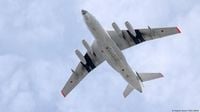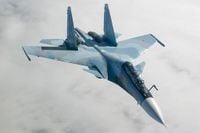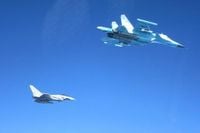On the evening of October 23, 2025, a tense incident unfolded in the skies over Lithuania that has sent ripples through European capitals and NATO headquarters alike. According to statements from the Lithuanian Ministry of National Defence and corroborated by multiple international news outlets, two Russian military aircraft—a Su-30 fighter jet and an Il-78 refueling tanker—crossed approximately 700 meters into Lithuanian airspace near the town of Kybartai, close to the border with Russia’s Kaliningrad region. The incursion, though brief at just 18 seconds, was immediately detected by Lithuanian air defense systems and prompted a rapid response from NATO’s Baltic Air Policing mission.
“Our forces acted quickly with NATO jets on patrol. Lithuania remains strong and ready. Every inch of our country is protected,” the Lithuanian Ministry of National Defence shared on X, underscoring the seriousness with which the country treats its territorial integrity. The Spanish Air Force, currently leading the NATO air policing mission in the region, scrambled two Eurofighter Typhoons from their base in Šiauliai, Lithuania, to intercept the Russian aircraft and patrol the area in the wake of the violation.
Lithuanian President Gitanas Nausėda wasted no time in publicly condemning the incident. “This evening, Russian military planes violated Lithuanian airspace. This is a blatant breach of international law and territorial integrity of Lithuania. Once again, it confirms the importance of strengthening European air defence readiness,” Nausėda declared, as quoted by the Lithuanian Ministry of Defence and reported by Deutsche Welle and RBC Ukraine. He further announced that Lithuania’s Foreign Ministry would summon Russian representatives to express a formal protest over what he described as “reckless and dangerous behavior.”
The Russian side, however, offered a different account. In a statement posted on Telegram, the Russian Ministry of Defense denied any incursion into Lithuanian airspace. “SU-30 fighters carried out a planned training flight over Russia’s Baltic Kaliningrad region and violated no borders of other countries,” the statement read. The ministry insisted that the flights “took place in strict observance of the rules of using airspace over the territory of the Russian Federation, did not deviate from their flight route and did not violate the borders of other states, which was confirmed by objective control means.” Notably, the Russian statement did not mention Lithuania by name.
This latest episode is not an isolated event. Since Russia’s full-scale invasion of Ukraine in 2022, tensions have simmered along NATO’s eastern flank. Airspace violations by Russian military aircraft over the Baltic region remain relatively rare, but they are highly sensitive and closely watched. According to Deutsche Welle and RBC Ukraine, Russian provocations have intensified in recent months. In September 2025, for example, three Russian MiG-31 fighter jets entered Estonian airspace near Vaindloo Island for about 12 minutes, prompting a strong reaction from Tallinn and NATO, which labeled the flight “reckless.” Italian F-35s, also deployed under the Baltic Air Policing mission, were scrambled in response. Moscow, as in Lithuania’s case, denied any wrongdoing.
Incidents have not been limited to manned aircraft. In late September, Lithuania authorized its armed forces to shoot down unmanned aerial vehicles entering its airspace after several Russian drones crashed near its border. Poland, Romania, Denmark, Latvia, and Estonia have all reported similar incursions by Russian jets and drones in recent weeks. The pattern has alarmed European leaders, who accuse Russian President Vladimir Putin of conducting a hybrid war—a strategy designed to test NATO’s resolve, probe for weaknesses, and instill anxiety among European citizens.
The Baltic states—Lithuania, Latvia, and Estonia—along with neighboring Finland and Poland, find themselves on the front lines of this new era of geopolitical tension. All share borders with Russia and a complicated history of occupation and resistance. The memory of Soviet domination remains fresh, and the prospect of renewed Russian aggression, especially in the wake of the war in Ukraine, looms large in the minds of policymakers and ordinary citizens alike. As Deutsche Welle noted, many in the region fear that Putin’s ambitions extend beyond Ukraine, with the Baltic states and other neighbors potentially in the crosshairs should Moscow succeed in its current campaign.
NATO’s Baltic Air Policing mission has become a critical component of the alliance’s deterrence posture. Operating out of Šiauliai Air Base in Lithuania and Ämari Air Base in Estonia, the mission provides continuous air defense coverage for the three Baltic states. The Spanish Air and Space Force currently leads the mission, with eight Eurofighter Typhoons stationed in Lithuania and Italian Typhoons based in Estonia. These forces are on high alert, ready to respond at a moment’s notice to any sign of unauthorized airspace entry—a readiness that was put to the test during the October 23 incident.
In the aftermath, Lithuania’s position has been unequivocal. The government, backed by support from NATO allies, has made clear its willingness to take more assertive measures if such violations continue. As reported by RBC Ukraine, several European governments, including Lithuania, have stated they are ready to shoot down Russian planes should there be another incursion into their airspace. This hardening of resolve has not gone unnoticed in Moscow, where officials have responded with what some European leaders describe as “hysteria.”
For its part, NATO has reiterated its commitment to defending every inch of allied territory. The alliance regularly intercepts Russian military flights operating without flight plans, transponders, or radio contact—activities that, while often remaining just outside NATO airspace, serve as persistent reminders of the region’s volatility. The October 23 breach, though fleeting, underscores just how quickly a routine day can escalate into a potential international crisis.
As the Baltic states and their NATO partners look to the future, the incident over Kybartai serves as a stark reminder of the high stakes at play. The response from Vilnius—swift, coordinated, and resolute—demonstrates both the seriousness with which these countries view their sovereignty and the importance of collective defense mechanisms in an increasingly uncertain world. The coming months will likely see continued vigilance, as European leaders balance deterrence with diplomacy in the face of ongoing Russian provocations.
For now, the skies over Lithuania are calm again, but the message from Vilnius and its allies could not be clearer: violations of NATO airspace will not be tolerated, and any further provocations will be met with a united and robust response.


